Les libellés Gmail permettent une organisation rapide, réduisant ainsi le temps nécessaire à la récupération des informations. Les étiquettes de Gmail offrent de la flexibilité grâce à des fonctionnalités telles que le codage couleur et les sous-étiquettes, ce qui les rend plus polyvalentes que les dossiers traditionnels. Ce guide vous explique le processus d'organisation étape par étape pour créer une boîte de réception claire, exploitable et bien organisée.
Passez à la réponse dont vous avez besoin dès maintenant :
- Comment créer une étiquette Gmail
- Comment partager une étiquette Gmail
- Comment ajouter des étiquettes Gmail avec des filtres
- Comment modifier une étiquette
- Comment créer une étiquette Gmail imbriquée
- Comment effectuer une recherche dans les étiquettes
- Comment gérer les tâches à l'aide des libellés Gmail
- Meilleures pratiques d'utilisation des libellés Gmail
Si votre équipe passe des heures par jour à envoyer des e-mails, Gmelius peut vous aider à vous organiser.
Inscrivez-vous à Gmelius via Google pour accéder à nos fonctionnalités et à nos intégrations Gmail !
Les étiquettes Gmail sont un outil puissant pour organiser votre boîte de réception et faciliter la recherche d'e-mails spécifiques. Contrairement aux dossiers traditionnels, les libellés Gmail vous permettent d'attribuer plusieurs libellés à un seul e-mail, ce qui vous offre plus de flexibilité et d'options de personnalisation. Cela signifie que vous pouvez classer un e-mail de plusieurs manières, afin de le retrouver plus facilement ultérieurement. Par exemple, un e-mail d'un client concernant un projet peut être étiqueté à la fois sous « Client » et « Projet », afin que vous puissiez le trouver quel que soit le contexte dans lequel vous recherchez.
En utilisant les libellés Gmail, vous pouvez rationaliser la gestion de vos e-mails et réduire le temps passé à rechercher des messages importants. Que vous gériez des e-mails personnels ou que vous vous occupiez de la coordination avec une équipe, les étiquettes peuvent vous aider à organiser et à optimiser votre boîte de réception.
Dans Gmail, les membres de l'équipe peuvent créer une étiquette pour classer les e-mails envoyés, reçus ou rédigés. En d'autres termes, les étiquettes sont un moyen simple d'organiser et de désencombrer votre boîte de réception.
Les libellés Gmail sont accessibles depuis la barre latérale gauche, affichées par une icône en forme de flèche (plus d'informations sur la façon de les colorier ultérieurement).
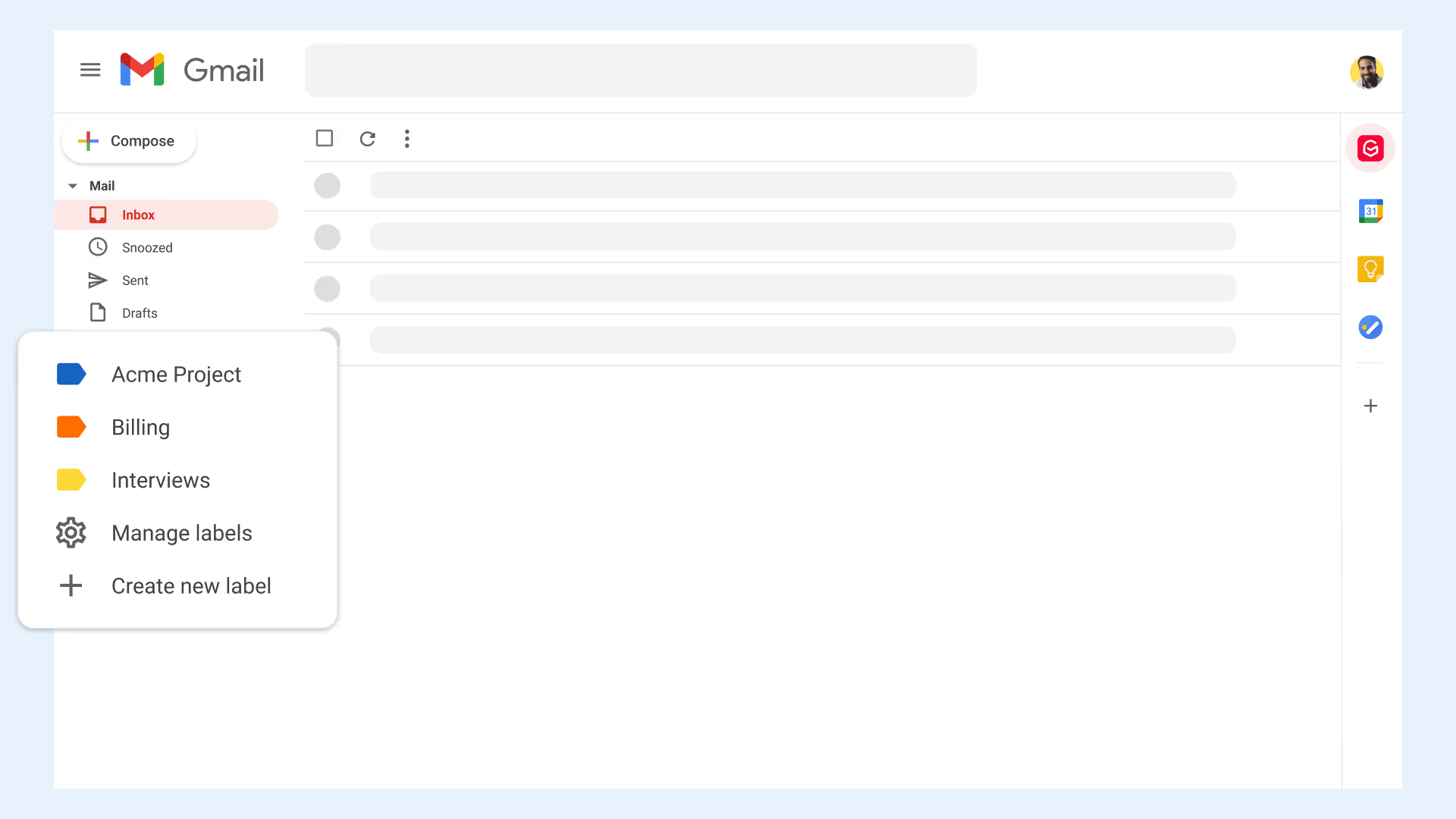
Étiquettes Gmail et dossiers
Tout comme les dossiers, les libellés regroupent les e-mails pertinents. Mais les utilisateurs de Gmail peuvent ajouter plusieurs libellés à un seul e-mail pour plus de flexibilité :contrairement à dossiers de courrier électronique.
Par exemple, les équipes commerciales peuvent utiliser des libellés d'e-mail pour organiser leur boîte de réception partagée en créant différents libellés, tels que « Prospects », « Contacts » et « Offres ». Les chefs de projet, quant à eux, peuvent créer une étiquette pour un projet donné et une autre pour classer les e-mails d'un fournisseur externe.
La création d'une étiquette est simple. Tout utilisateur Gmail connecté dispose de 3 options :
- Dans un e-mail, sélectionnez l'icône « Étiqueter comme » en haut de la fenêtre. Sélectionnez ensuite « Créer une nouvelle étiquette » et nommez l'étiquette en conséquence.
- Dans le menu de gauche, sélectionnez « Créer une nouvelle étiquette », entrez le nom de la catégorie et, si nécessaire, de la sous-catégorie.
- Dans le coin supérieur droit de la fenêtre, sélectionnez l'icône représentant un engrenage, puis « Paramètres » dans le menu déroulant. Ensuite, sélectionnez « Étiquettes », puis « Créer une nouvelle étiquette ».
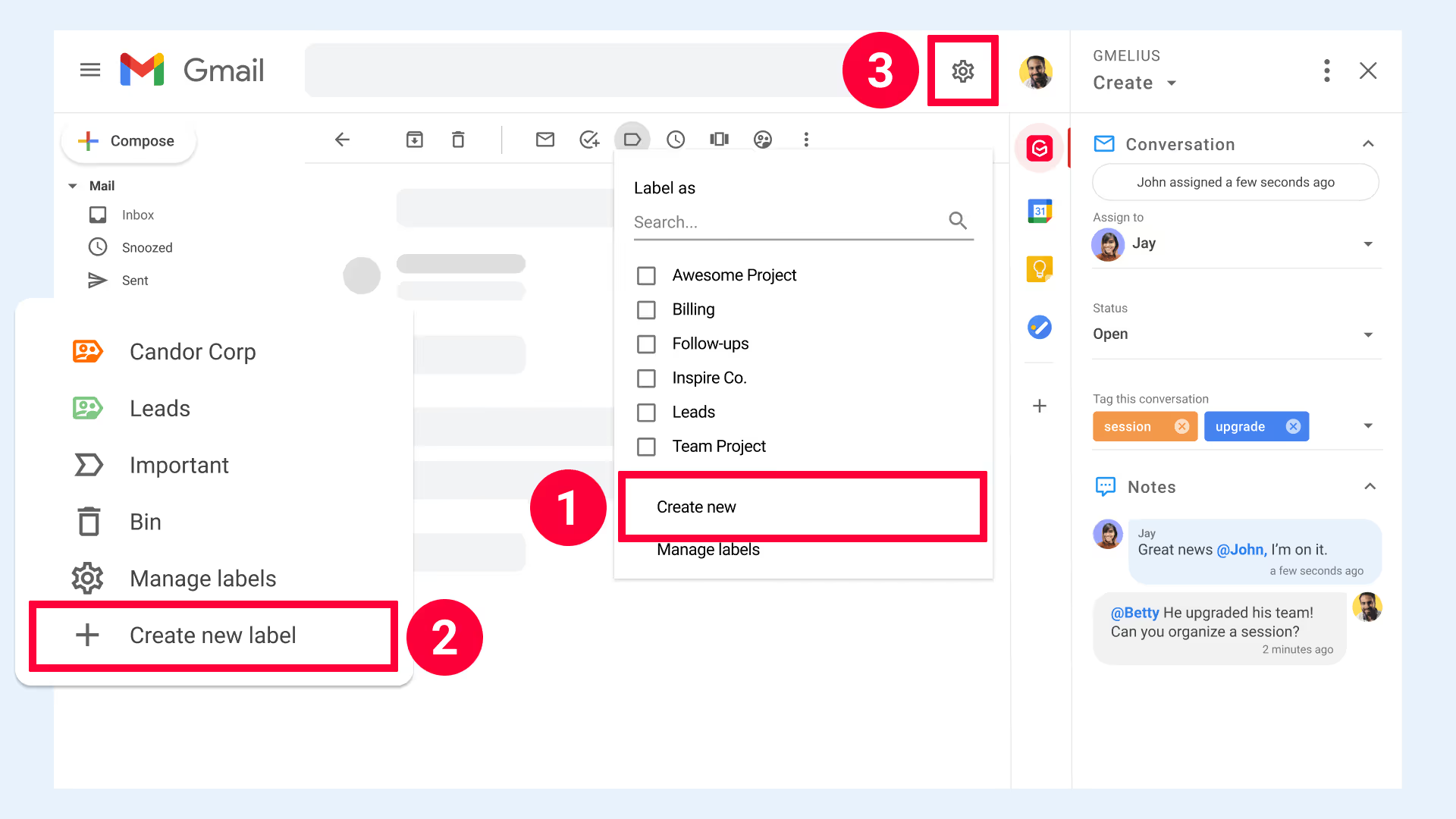
Les solutions de messagerie sont très utiles pour beaucoup, mais elles ont été conçues à l'origine pour un usage individuel. Cela crée de sérieux obstacles pour les équipes modernes qui travaillent en collaboration entre les départements, les bureaux, les sites et les fuseaux horaires. Avec Gmelius, vous pouvez partagez vos étiquettes avec votre équipe. Les équipes peuvent créer, gérer et partager des étiquettes existantes avec d'autres membres de l'équipe ou des contacts externes. Tous les membres inclus dans une étiquette partagée ont accès aux e-mails, et aux fils de discussion complets (y compris les réponses futures), classés sous l'étiquette. Le partage d'étiquettes peut favoriser la transparence et la responsabilité autour des e-mails d'équipe, qui contribuent à renforcer l'efficacité et la réussite de la collaboration en équipe.
Et si votre équipe est sur Slack, vous pouvez même utiliser le Intégration à Gmelius Slack pour créer une synchronisation complète entre les étiquettes partagées et les chaînes Slack que vous avez choisies.
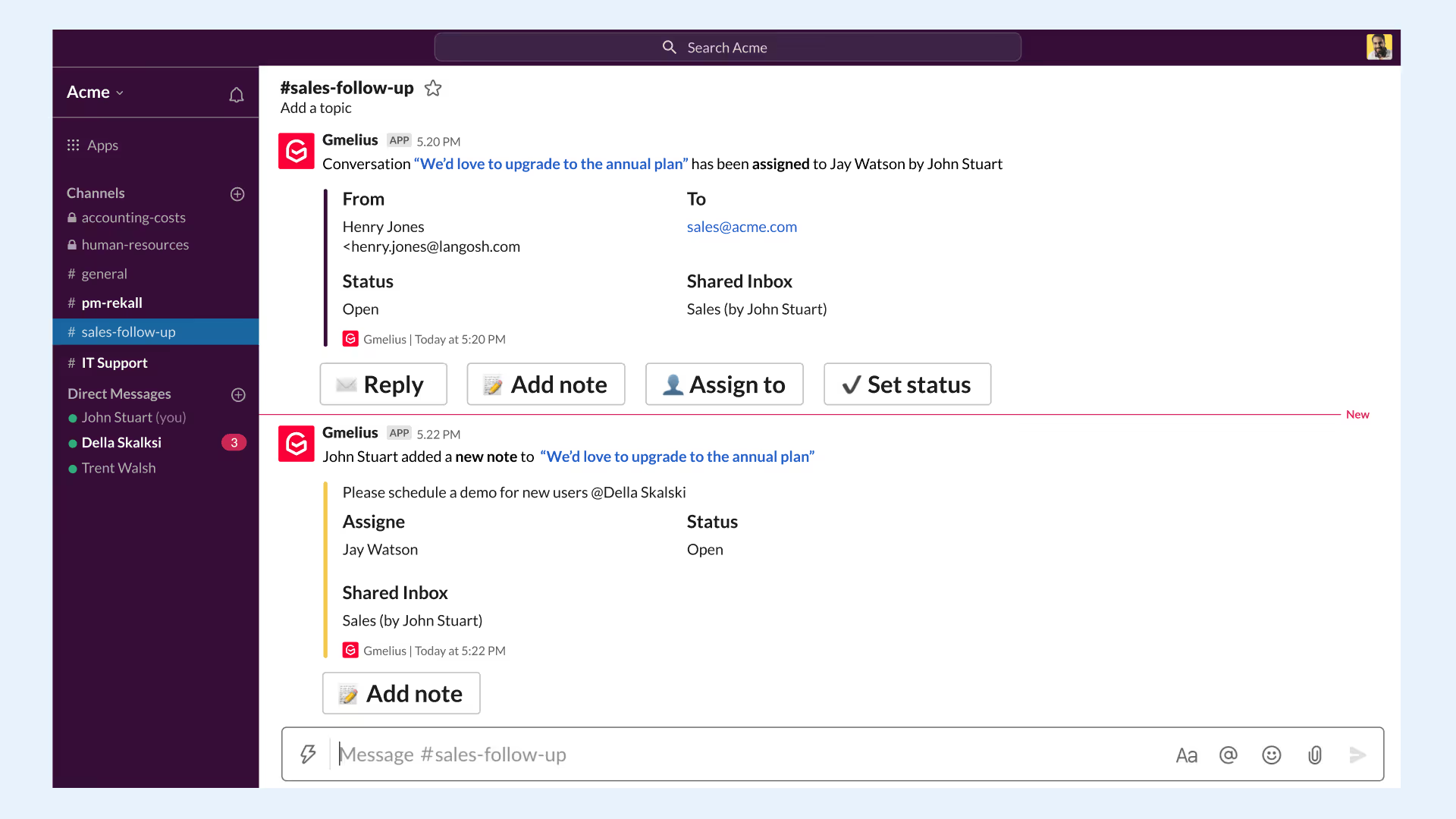
Pour plus de détails avec des captures d'écran, suivez l'article sur comment créer une étiquette partagée.
Bien que vous puissiez toujours ajouter une étiquette manuellement, l'automatisation du processus vous fera gagner beaucoup de temps. Selon votre cas d'utilisation, il existe plusieurs manières d'ajouter automatiquement des libellés aux e-mails.
Utiliser des filtres pour ajouter une étiquette
Vous pouvez ajouter une étiquette à l'aide d'un filtre. C'est rapide, facile et vous permet de automatisez votre boîte de réception catégories :
- Dans Gmail, cliquez sur l'icône représentant un engrenage et sélectionnez « Paramètres ».
- Cliquez ensuite sur « Filtres et adresses bloquées » en haut de la page.
- Sélectionnez « Créer » pour appliquer un nouveau filtre.
- Sélectionnez la manière dont vous souhaitez que le courrier soit filtré. Par exemple, vous pouvez utiliser des mots spécifiques ou le nom de l'expéditeur.
- Cliquez sur « Créer un filtre » avec cette recherche.
- Cochez « Ignorer la boîte de réception » et « Appliquer » pour appliquer l'étiquette.
- Cliquez sur « Créer un filtre ».
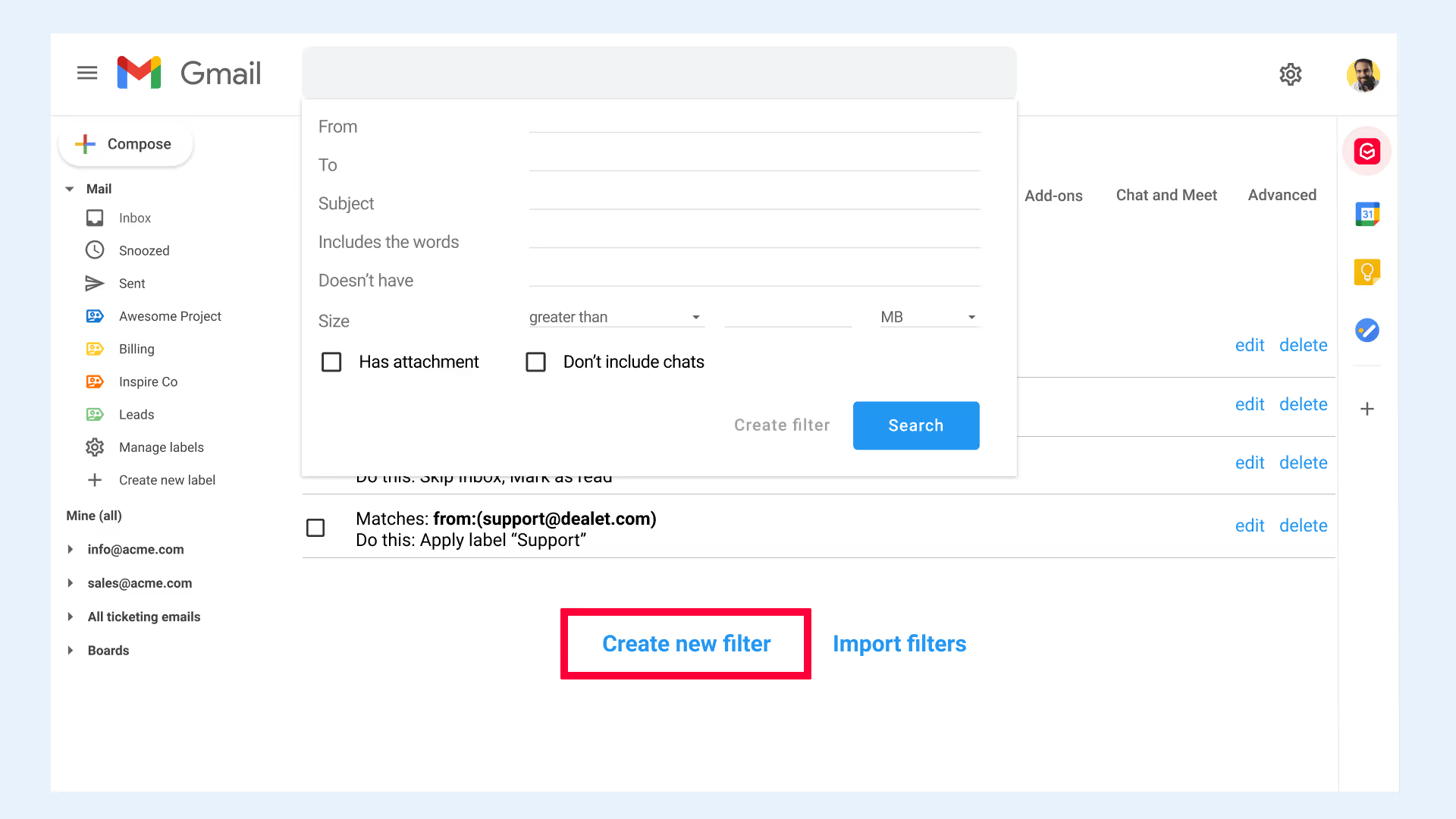
Ajouter ou supprimer des étiquettes en masse
Vous pouvez également ajouter ou supprimer facilement des étiquettes de plusieurs e-mails en une seule fois en suivant ces étapes simples :
- Sélectionnez les messages entrants auxquels vous souhaitez ajouter ou supprimer des libellés spécifiques.
- Cliquez sur l'icône « Étiqueter comme » en haut.
- Sélectionnez ou désélectionnez n'importe quel libellé.
- Cliquez sur « Appliquer ».
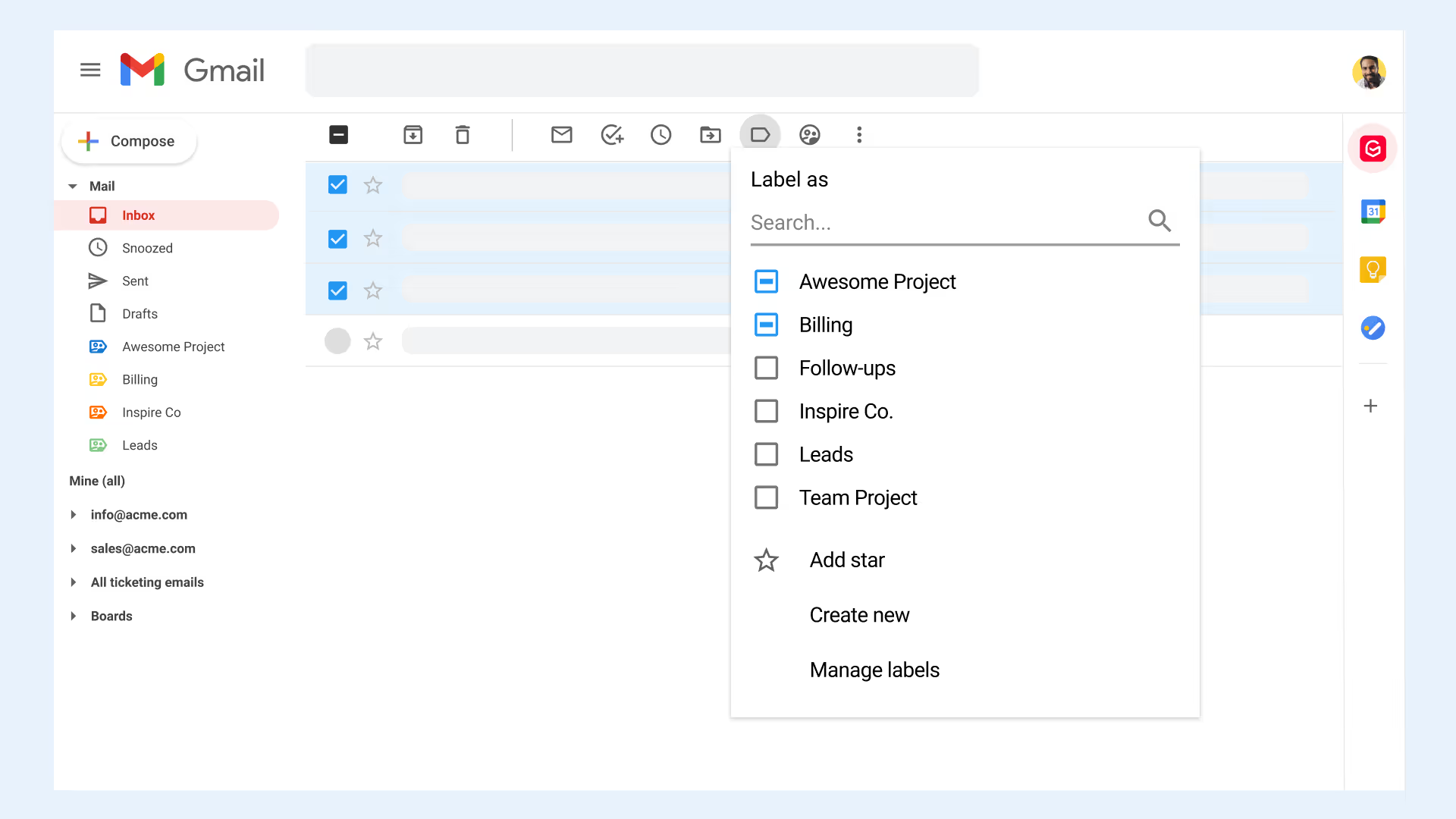
Utilisez le bouton « Déplacer vers » pour appliquer une étiquette
Le bouton « Déplacer vers » permet aux utilisateurs d'archiver les e-mails en quelques clics.
- Ouvrez ou sélectionnez le ou les e-mails que vous souhaitez déplacer.
- Sélectionnez l'icône « Déplacer vers » en haut.
- Sélectionnez le dossier ou l'étiquette de destination sous lequel vous souhaitez déplacer le ou les e-mails.
Pour déplacer plusieurs e-mails, il vous suffit de sélectionner plusieurs e-mails et de les faire glisser vers l'étiquette de votre choix dans votre boîte de réception Gmail.
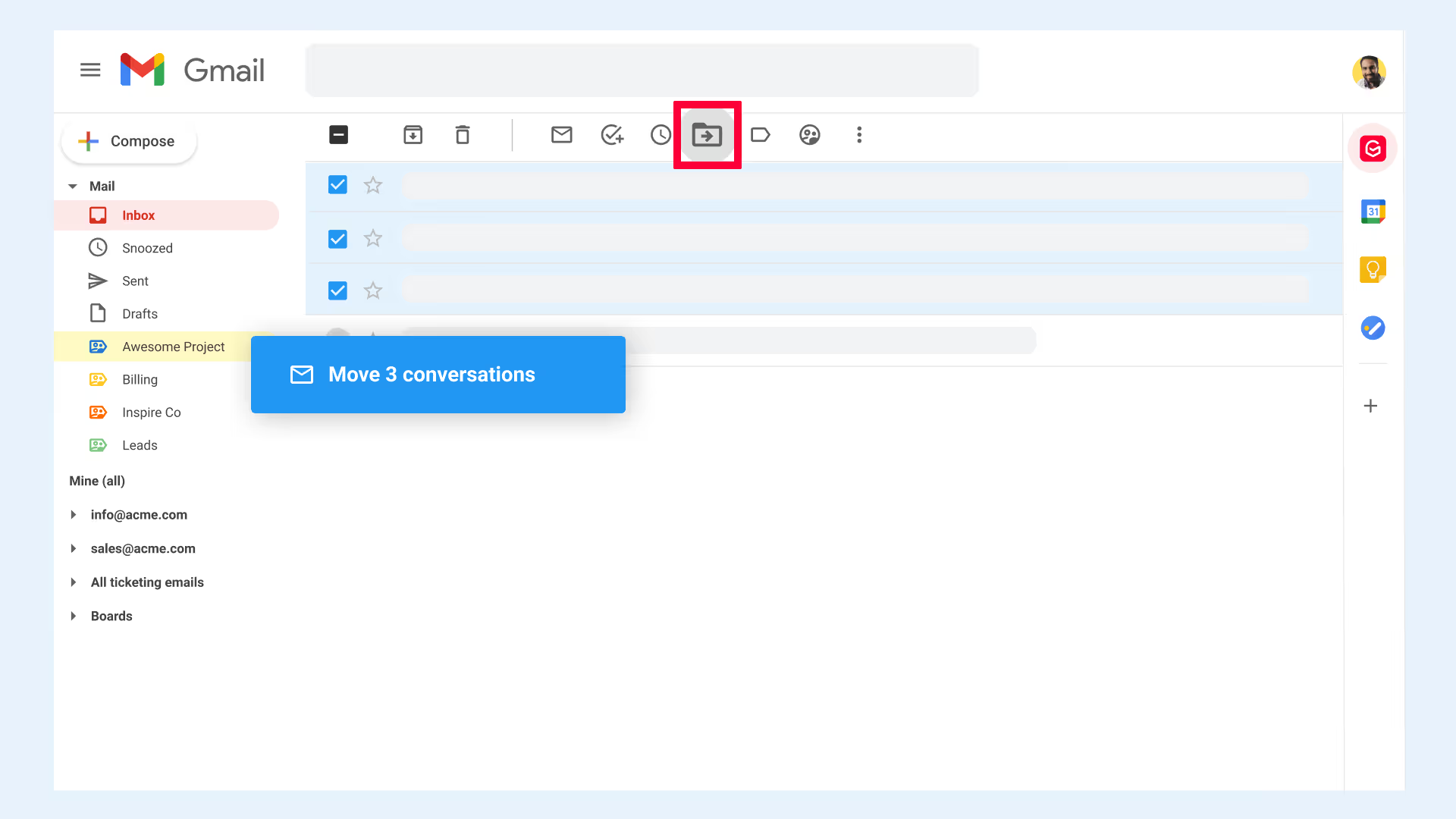
Ajouter des libellés aux e-mails sortants
L'ajout d'étiquettes aux e-mails sortants permet aux équipes de conserver une trace complète des informations stockées dans un endroit organisé. Pour ce faire :
- Rédigez un message depuis votre compte Gmail
- Sélectionnez l'icône « Plus d'options » (les trois points empilés sur le côté droit) dans la barre d'outils en bas de la fenêtre de composition.
- Choisissez « Étiquettes » dans le nouveau menu qui s'ouvre.
- Un autre menu apparaîtra avec les étiquettes disponibles ; cochez celle (s) que vous souhaitez utiliser. Ou sélectionnez « Créer un nouveau » et entrez le nom de votre nouveau label.
- Vous pouvez également choisir d'ajouter une étoile au message dans le même menu si nécessaire.
- Sélectionnez à nouveau le corps de votre message pour fermer tous les menus.
- Rédigez votre message et cliquez sur Envoyer comme d'habitude. Le ou les libellés que vous avez choisis seront appliqués au message et à toute chaîne d'e-mails en cours.
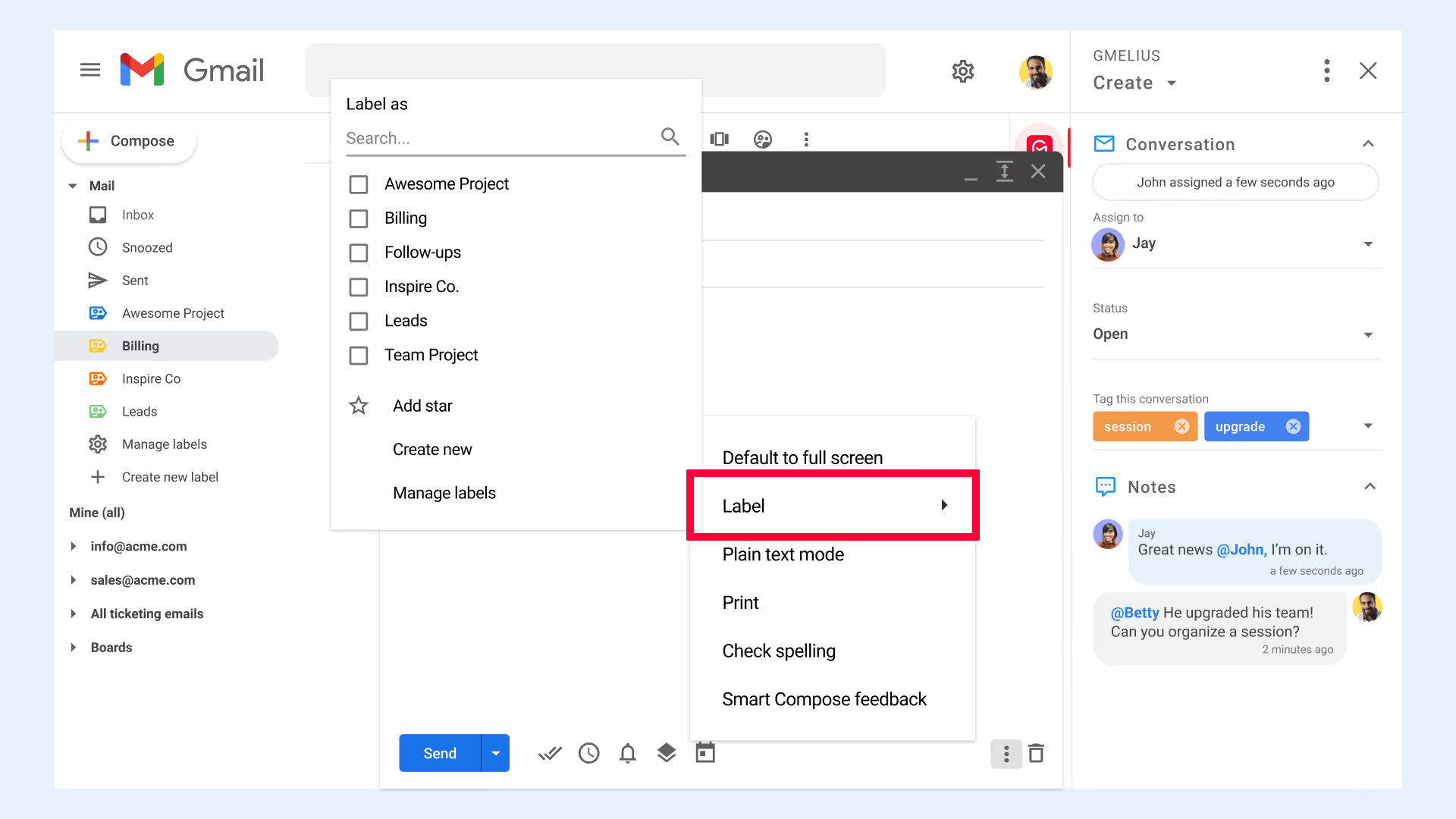
Ajoutez des étiquettes et créez des modèles à l'aide de l'automatisation avancée
Gmail est sans doute le fournisseur de messagerie le plus complet du marché. Cependant, pour obtenir les meilleurs résultats, vous avez besoin de fonctionnalités d'automatisation avancées telles que des modèles et des séquences d'e-mails. Gmelius permet aux utilisateurs de créer, partager et envoyer modèles d'e-mails personnalisés et des séquences de suivi automatisées basées sur les interactions des destinataires.
Pour ce faire, tout d'abord, installez Gmelius et créez un modèle d'e-mail à l'aide de la fonction « Label As ». Une fois qu'un modèle est sélectionné dans la fenêtre de composition, l'étiquette est appliquée automatiquement.

Les séquences peuvent également être utilisées comme fonction d'automatisation avancée. Quand création d'une séquence automatisée, vous pouvez demander à Gmelius d'ajouter des étiquettes à certaines étapes du flux de travail.
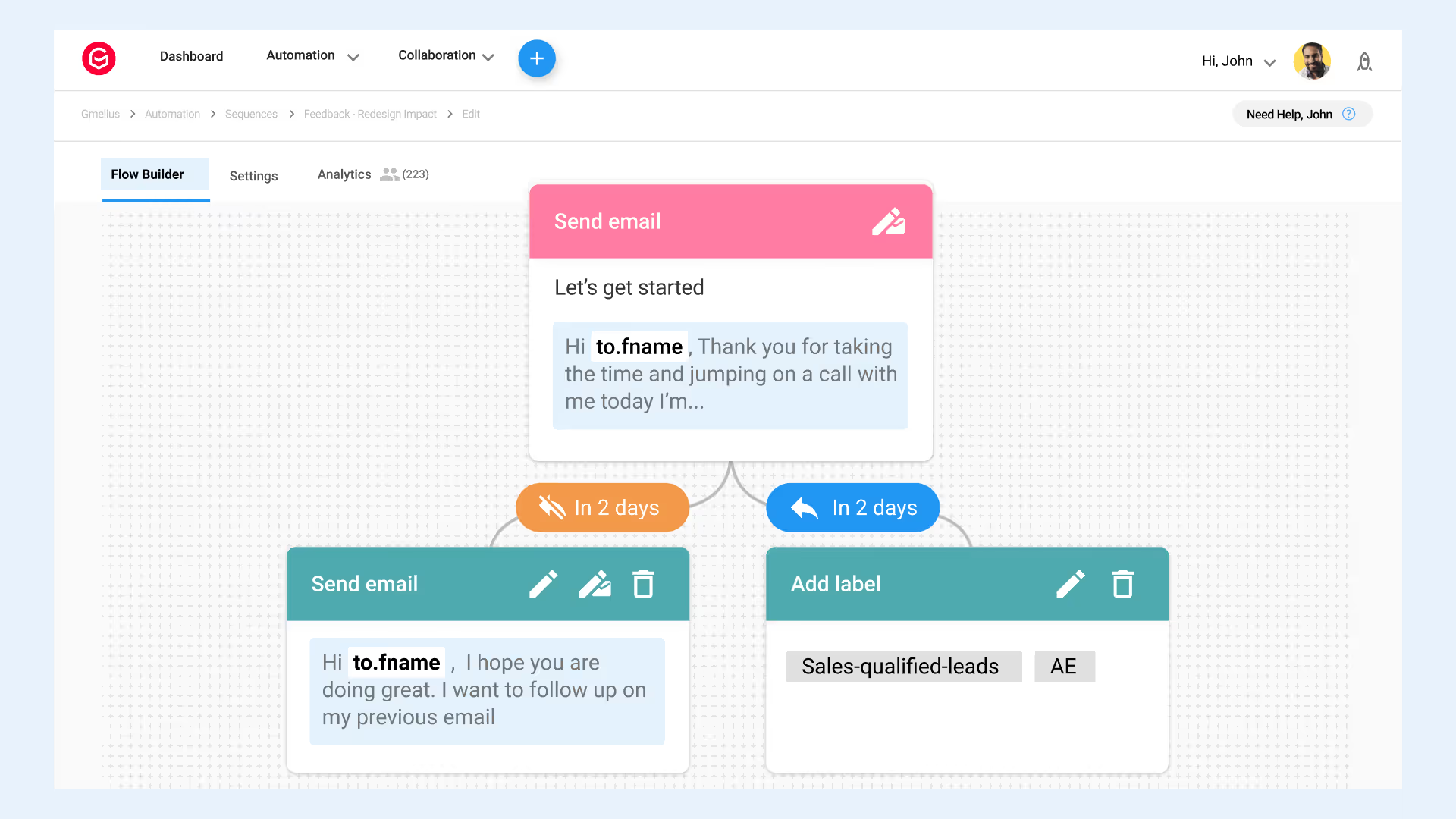
Tous les modèles, séquences et conversations d'e-mails sont synchronisés en temps réel sur l'ensemble de votre équipe et sur tous ses appareils. Ainsi, une fois que vous recevez une réponse, vous trouverez l'e-mail sous le libellé de votre choix.
Une fois que vous avez créé une étiquette dans Gmail, vous pouvez également modifier la couleur, le nom et la visibilité de l'icône de l'étiquette afin de gérer vos étiquettes Gmail de manière plus évolutive et de garder votre boîte de réception Gmail organisée sur le long terme.
Pour modifier l'étiquette, procédez comme suit :
- Sur un ordinateur, ouvrez Gmail (les libellés ne peuvent pas être modifiés depuis l'application Gmail).
- Sur le côté gauche de la page, placez votre curseur sur le nom de votre étiquette.
- Cliquez sur la flèche vers le bas dans le menu déroulant.
- Cliquez sur « Modifier ».
- Apportez des modifications à votre étiquette.
- Cliquez sur « Enregistrer ».
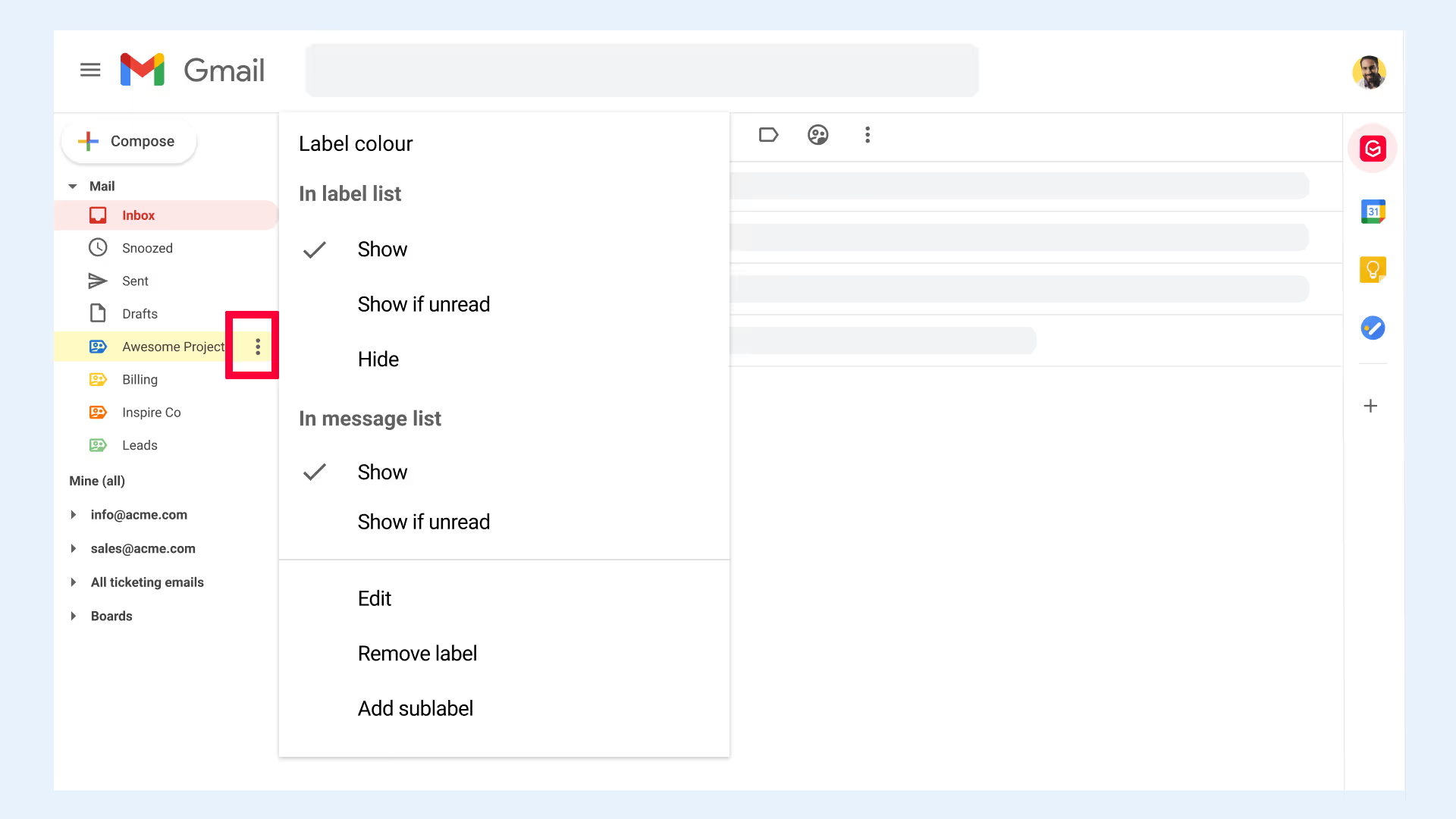
Pour les projets plus complexes, les utilisateurs peuvent imbriquer des étiquettes dans des catégories de niveau supérieur (parent). Par exemple, si votre entreprise fournit comptabilité et pour les services fiscaux, vous pouvez créer une étiquette parent pour « taxes » et des sous-étiquettes pour chaque client que vous servez.
Voici comment configurer une étiquette imbriquée dans Gmail :
- Sélectionnez l'icône représentant un engrenage dans le coin supérieur droit de la fenêtre, puis choisissez « Paramètres » dans le menu déroulant.
- Sélectionnez « Étiquettes » si l'onglet Étiquettes n'est pas affiché.
- Sélectionnez « Créer une nouvelle étiquette » et saisissez un nouveau nom d'étiquette.
- Sélectionnez une étiquette de niveau supérieur dans le menu déroulant de la section d'étiquettes « Nest ».
- Si vous devez déplacer une sous-étiquette existante vers une autre étiquette de niveau supérieur, accédez à la section « Étiquettes » et recherchez l'étiquette que vous souhaitez modifier.
- Sélectionnez « Modifier » dans la colonne Actions.
- Choisissez une nouvelle étiquette de niveau supérieur dans le menu déroulant de l'étiquette « Nest ».
- Cliquez sur « Créer » ou « Enregistrer ».
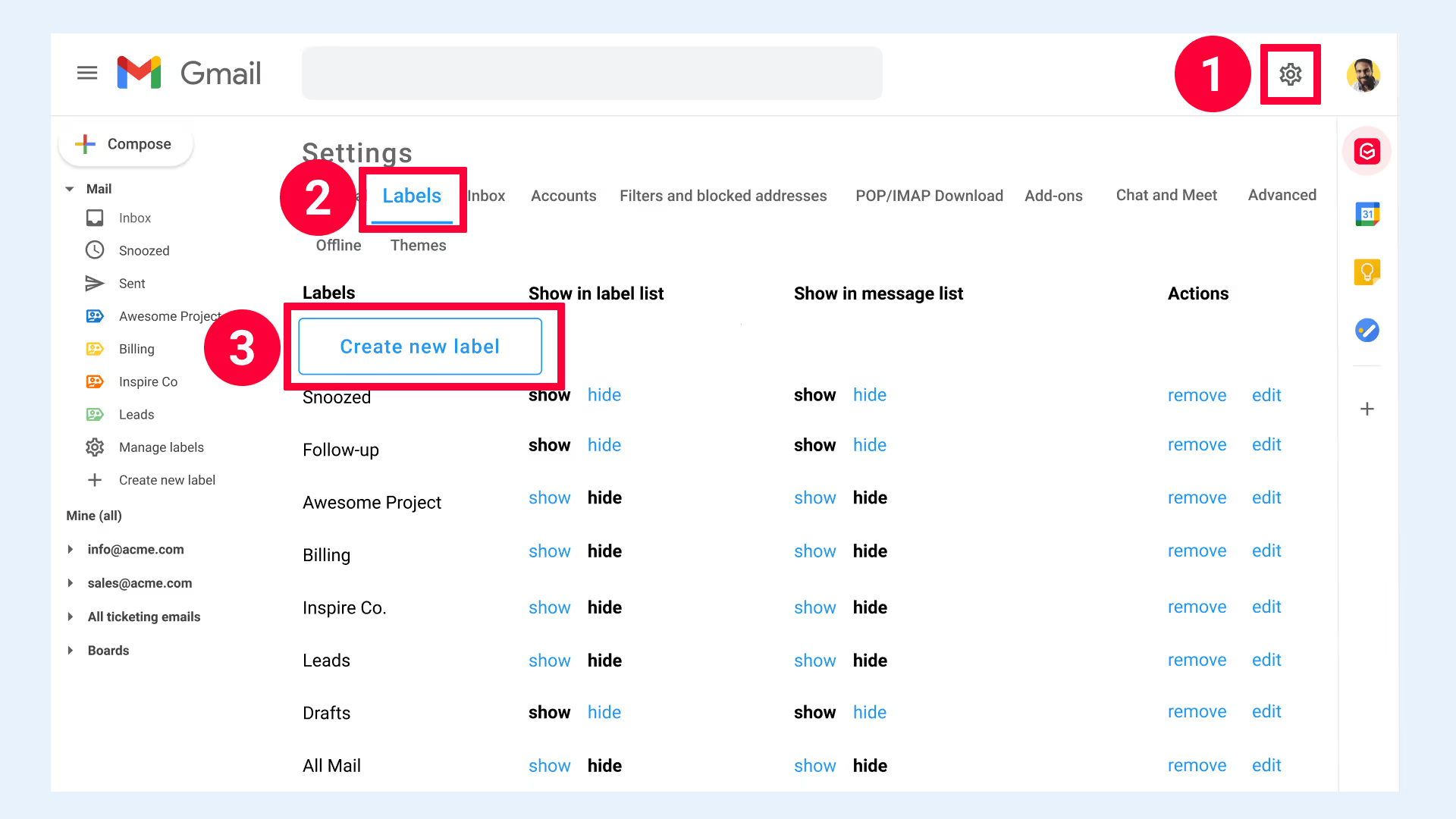
Pour annuler l'imbrication d'une étiquette, procédez comme suit :
- Dans la section « Étiquettes », recherchez la sous-étiquette que vous souhaitez convertir.
- Dans la colonne Actions, sélectionnez « Modifier ».
- Désélectionnez l'étiquette « Nest ».
- Sélectionnez « Enregistrer ».
La recherche à l'aide de plusieurs filtres peut être intimidante, mais vous pouvez obtenir beaucoup de résultats si vous avez les bonnes requêtes en place. Par exemple, vous pouvez rechercher tous les e-mails sous une seule étiquette envoyés par une adresse e-mail spécifique.
Pour effectuer une recherche, procédez comme suit :
- Dans la barre de recherche en haut de Gmail, saisissez le « label : label_title ».
- Utilisez les flèches vers le haut et vers le bas pour mettre en surbrillance l'étiquette que vous souhaitez ouvrir.
- Cliquez sur « Entrée » pour afficher les e-mails figurant dans cette étiquette.
- Appuyez sur la barre d'espace après le nom de l'étiquette et saisissez le texte que vous souhaitez rechercher dans l'étiquette. Par exemple, si vous ne souhaitez voir que les e-mails provenant d'une seule adresse e-mail, entrez le libellé : « label_title email_address ».
Les libellés Gmail offrent de nombreuses options uniques pour organiser les tâches. Avec Gmelius, les équipes peuvent gérer des tâches et des projets avec des étiquettes, car notre plateforme unique offre une suite de gestion de projet depuis Gmail. Les équipes peuvent transformez les étiquettes en tableaux Kanban directement dans Gmail. Les e-mails deviennent des cartes de tâches faciles à visualiser, et vous pouvez les déplacer d'une colonne à l'autre pour vous aider à mener à bien les tâches.
Grâce à de puissantes fonctionnalités d'automatisation, les membres de l'équipe peuvent définir des règles pour placer automatiquement les tâches dans la colonne de droite. Vous n'avez donc pas besoin de glisser-déposer les fiches de tâches manuellement. Les membres de l'équipe peuvent également transformer une étiquette en tableau Kanban.
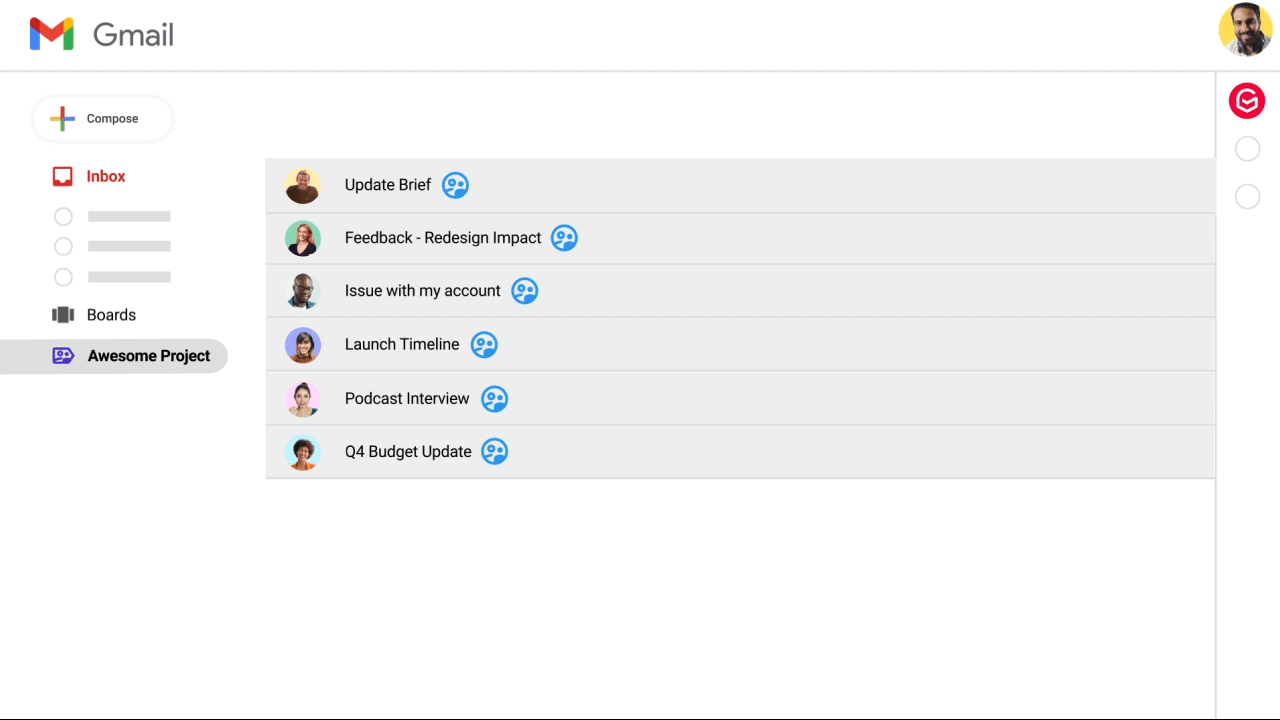
Vous pouvez même intégrer vos tableaux Kanban à Trello à l'aide de Gmelius. Notre Intégration bidirectionnelle de Gmail à Trello vous permet de synchroniser vos tableaux en temps réel afin de réduire la dispersion des données ou les lacunes en matière de communication.
Si votre équipe possède déjà un tableau personnalisé sur Trello, mais souhaite avoir la possibilité de travailler depuis Gmail, vous pouvez importer vos tableaux Trello dans Gmail à l'aide de Gmelius.
Pour en savoir plus sur notre intégration bidirectionnelle entre Gmail et Trello, lisez ceci article.
Les étiquettes Gmail constituent une fonctionnalité intéressante de Gmail qui vous permet de personnaliser et d'organiser votre flux de travail par projet, par client, et plus encore ! Cependant, Gmail ne fait pas tout à lui seul. Heureusement, la puissante combinaison de Gmail et de Gmelius permet aux équipes d'être plus productives, de gagner du temps et d'améliorer la transparence et l'alignement.
Conseils pour utiliser efficacement les libellés Gmail
Voici quelques conseils pour utiliser efficacement les libellés Gmail :
- Utiliser plusieurs étiquettes: attribuez plusieurs libellés à un seul e-mail pour le classer de différentes manières. Cette flexibilité vous permet de rechercher des e-mails en fonction de différents contextes.
- Création d'étiquettes imbriquées: créez des étiquettes imbriquées pour organiser les e-mails associés sous une étiquette parent. Par exemple, vous pouvez avoir un libellé parent pour les « Projets » et des libellés imbriqués pour chaque projet spécifique. Idem pour les clients, les départements et les employés.
- Utiliser des étiquettes pour les notifications: utilisez des libellés pour contrôler les messages qui déclenchent des notifications, ce qui permet de personnaliser davantage les paramètres de notification.
- Organisez votre liste d'étiquettes: Organisez votre liste d'étiquettes en affichant ou en masquant les étiquettes selon les besoins. Cela permet de maintenir une boîte de réception propre et ciblée.
- Utilisez des libellés pour des recherches plus intelligentes: utilisez des libellés comme variables dans les recherches pour affiner les résultats et faciliter la recherche de messages spécifiques.
- Appliquez des étiquettes lors de la composition: appliquez des libellés aux nouveaux messages lors de la rédaction pour vous assurer que l'e-mail et les réponses restent organisés.
- Laissez Gmail appliquer des libellés pour vous: laissez Gmail appliquer des libellés aux messages en fonction de critères spécifiques à l'aide des filtres Gmail ou des règles Gmelius. Cela vous permettra de gagner du temps et de rationaliser la gestion de vos e-mails.
En suivant ces conseils, vous pouvez tirer le meilleur parti des libellés Gmail et rendre la gestion de vos e-mails plus efficace.
Êtes-vous prêt à organiser votre boîte de réception à l'aide d'étiquettes Gmail ? Découvrez nos fonctionnalités et intégrations et améliorez la communication et la collaboration au sein de l'équipe. INSCRIVEZ-VOUS aujourd'hui !
.avif)


.avif)
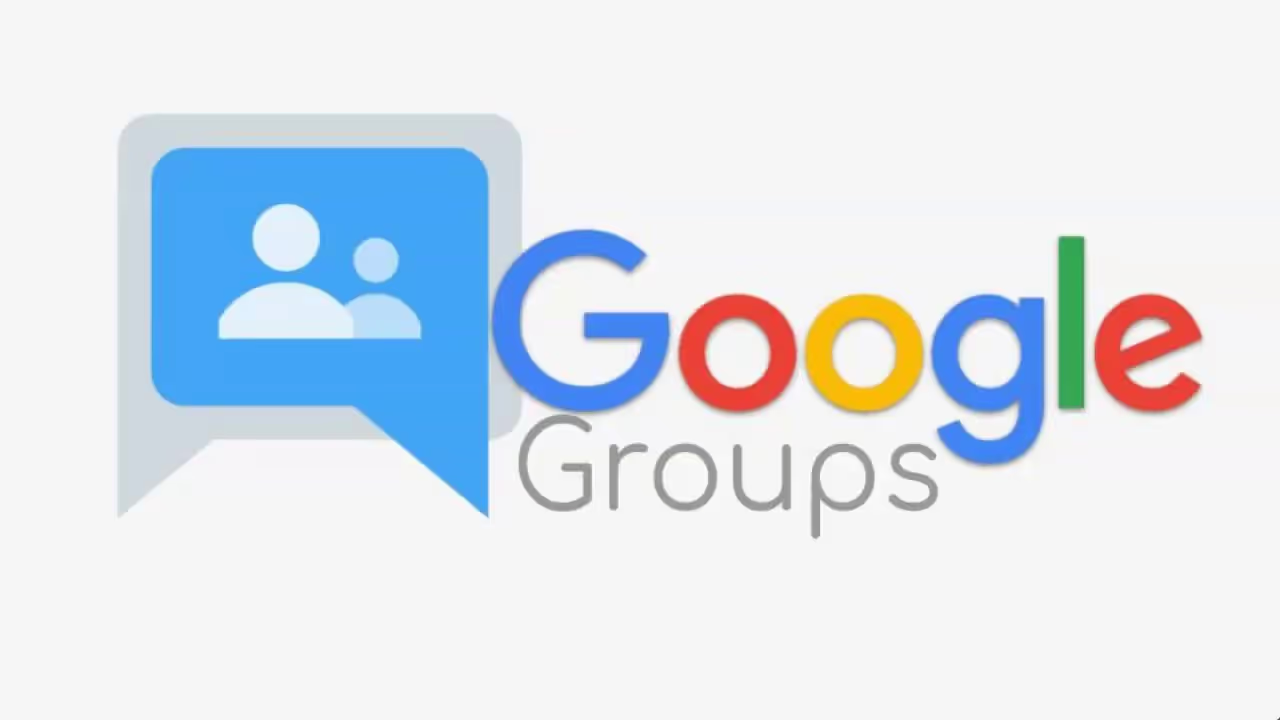
.avif)
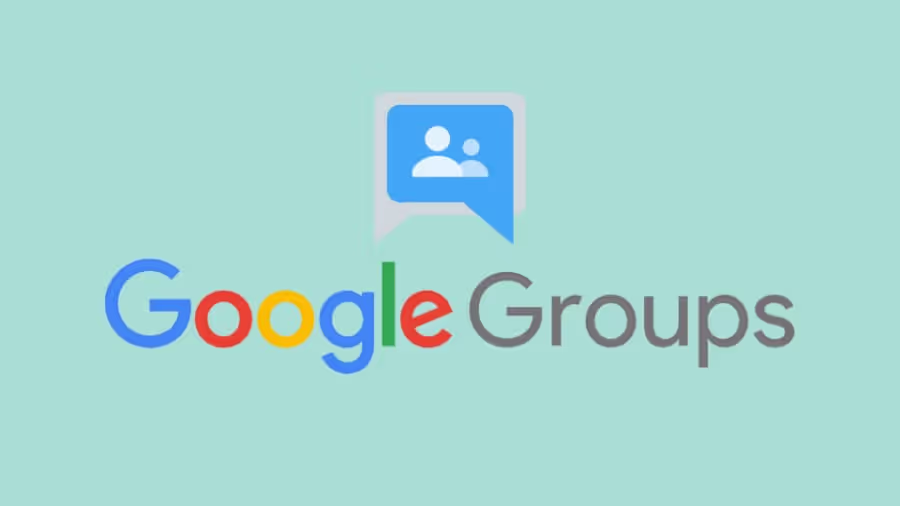
.avif)
.avif)